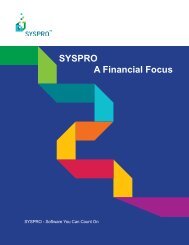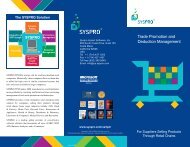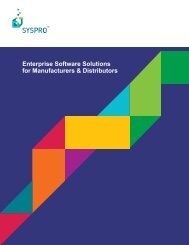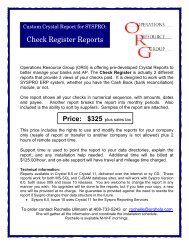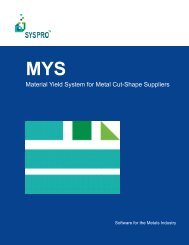Teach Yourself e.net - Syspro
Teach Yourself e.net - Syspro
Teach Yourself e.net - Syspro
You also want an ePaper? Increase the reach of your titles
YUMPU automatically turns print PDFs into web optimized ePapers that Google loves.
place invoice details in invoice reprint file, order set to status “9 - Complete”. SORTIC<br />
7. Retrieve invoice details and produce own document. SORQID<br />
7.2. Sales Order Processing - Billing<br />
This process defines the steps needed for processing a sales order of type Billing. Like the<br />
previous process, there are no back order lines included.<br />
1. Build information for sales order header. SORRSH<br />
2. Build information for sales order detail line(s). SORRSL<br />
3. Create sales order in status “8 - Ready to invoice”. SORTOI<br />
4. “Invoice” ie update Accounts Receivable and Inventory. Allocate invoice number,<br />
place invoice details in invoice reprint file, set order status to “9 - Complete”. SORTIC<br />
5. Retrieve invoice details and produce own document. SORQID<br />
As you can see, the process is almost identical to the previous one. The first three steps<br />
and the final step are the same. This shows us that certain business objects work together<br />
and provide data and system functions that other business objects need. For further<br />
information about the business objects please visit SYSPRO's Support Zone<br />
(http://support.syspro.com/.<br />
A knowledge of business process logic and programming logic is required when<br />
formulating e.<strong>net</strong> solutions processes. For this reason it is quite common that a team of<br />
developers work together, some with greater knowledge of business process and others<br />
with greater programming expertise.<br />
Both these process have detailed steps of a Sales Order without back order lines included.<br />
The final process that we will examine in this chapter shows a Sales Order process with<br />
back orders.<br />
7.3. Sales Order Processing - With Back Orders<br />
By now you should be familiar with the Sales Order process and so can concentrate on the<br />
differences that occur when one or many lines go into back order.<br />
1. Build information for sales order header. SORRSH<br />
2. Build information for sales order detail lines. SORRSL<br />
3. Create sales order in status “1 - Open order”. SORTOI<br />
4. Retrieve order details to produce own delivery note document for lines not on back<br />
order. This puts document in to status "4 - In warehouse". SORQOD<br />
5. Change order status from "4 - In warehouse" to "8 - Ready to invoice". SORTOS<br />
7–4





